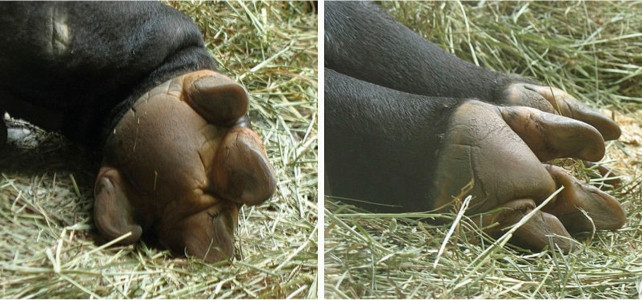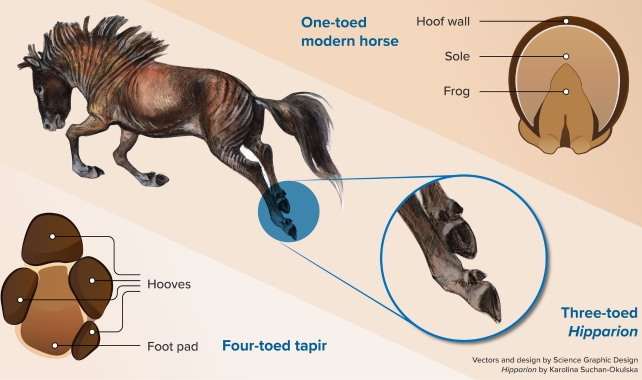Horses' ancient ancestors once trotted across the landscape on a small number of hooved toes, evolving over the ages to a single solid hoof we see today.
According to a comprehensive analysis of horse history, those extra digits truly are now gone. Scientists say it rules out a recent hypothesis that toes were retained in the hoof and supports the earlier idea that evolution completely eliminated them.
A research team from the UK, US, and the Netherlands looked at perissodactyl (odd-toed hooved animal) fossil records, along with photos of modern horse hoof prints and details of their foot bones, to get to the bottom of what happened to those extra toes.
Research on the ancestry of modern horses has considered their foot changes an evolutionary progression. The early horse-like ancestor Eohippus angustidens had hooved feet with a pad underneath, just like modern tapirs, with four toes on their front feet and three at the back.
Today's perissodactyls include the Equidae family of horses, asses, and zebras, with feet that consist of only one toe (the original third toe), surrounded by a tough yet flexible keratinous hoof. Underneath, on the sole is a V-shaped shock absorber called the frog.
"This anatomical change has been interpreted as an adaptation for life in open habitats," the study authors write in their published paper, "along with the acquisition of hypsodont (high-crowned) cheek teeth for grazing (or incorporating at least some grass in the diet), and larger body size."
The other modern perissodactyls are the tapirs (who have cleverly managed to hang on to all of their toes) and rhinos, who've done okay considering, but have gone and lost the fourth toe on their front feet, leaving them with three apiece.

"In later fossil horses there were only three toes front and back," says vertebrate paleontologist Christine Janis from the University of Bristol in the UK.
"The extra toes, known as side toes, in these horses were smaller and shorter than in a tapir, and likely did not touch the ground under normal circumstances, but they may have provided support in exceptional situations, such as sliding or forceful impact."
So how did modern horses end up with only one toe per foot? And where did that rubbery frog on the bottom come from?
"The upper portions – the remains of the additional hand and foot bones – remain as 'splint bones' fused with the remaining central one," Janis adds, "but where are the fingers and toes?"
Although there aren't any actual bones in the frog, a 2018 study put forward the hypothesis that in modern horses, these outer toes were 'absorbed' into the hoof of the central toe over the generations and contributed to the frog.

This was based in part on an analysis of hoof prints left by a three-toed horse relative called Hipparion (not in direct lineage to modern horses) that lived in Tanzania's Laetoli 3.7 million years ago.
The site is a hotbed for history, like the famous "Laetoli Footprints" attributed to the early hominins Australopithecus, and more recently prints that suggest they were taller than we expected.
In the case of the Laetoli hoof prints, the absence of a frog supported the 2018 study's hypothesis, that modern horses' frogs are derived from the side toes of characters like Hipparion.
But Janis and colleagues state there's evidence to contradict this, such as that many hoof prints made by ancient three-toed horses clearly show the telltale sign of a frog, indicating it's been around for quite some time in horse history.
They also argue frogs aren't visible in every hoof print of modern horses, known to have them, so the absence of a frog in a print doesn't hold weight.

Their results cast doubt on the hypothesis that the frog of modern horse hooves evolved from the side toes of their three-toed ancestors.
"The frog of the horse's hoof evolved independently of the side toes as a unique structure providing shock absorption and traction during locomotion," explains lead author Alan Vincelette, a biologist from St. John's Seminary, Camarillo in the US.
The researchers also noted that one-toed horses tend to have rounder feet compared to the oval shape of that toe on a three-toed horse, perhaps for distributing weight differently. They add that the frog is likely a remnant of that forgotten footpad, modified for shock absorbing.
"While the notion that modern horses have retained all of their original toes as within-hoof remnants is a novel one, and so rather appealing, it can be shown to be incorrect," concludes Janis.
Misplacing toes isn't quite in the same league as leaving your keys at home, but horses have since evolved to become powerful agile creatures, valued by many species and adored by humans. Plus pedicures are probably cheaper these days.
The review has been published in Royal Society Open Science.
